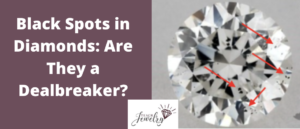
You might find a diamond that has all the right qualities, but then you notice something’s not right.
There’s a black spot within its facets, marring its perfection.
When I was shopping for an engagement ring for my wife, this inclusion was the type that jumped out first with so many diamonds I viewed in person and online.
I removed those from consideration because my focus was on eye-cleanliness, which means it appears flawless when viewed without magnification.
I’ll share everything you need to know about black spots on diamonds, including if they can be removed, how they impact quality, and ways to make them less visible.
What are Black Spots in Diamonds?
A black spot in a diamond is a carbon flaw. Diamonds are made of crystalized carbon, and these black spots are the result of carbon that never fully crystalized. They’re natural flaws, not man-made, and are a part of the diamond’s inherent structure.
To see an example, check out the high-resolution image of this round-cut diamond that has a few black spots within its table.
It’s from the vendor where I bought my wife’s engagement ring.
Black spots are one of the most common blemishes.
Their visibility often depends on the lighting the diamond is under, as the diamond will reflect and refract light at different angles.
Unlike other imperfections, black spots don’t negatively impact the integrity of the gem or weaken it.
Rather, they are part of its structural strength, and trying to remove them can weaken it (but more on that later).
There’s a whole category called salt and pepper diamonds, where the black spots are part of its distinguishing features, but this branding is often an attempt to sell diamonds that otherwise wouldn’t have interest from buyers because of the inclusions.
How do Black Spots Affect Clarity Grades?
The clarity grade of a diamond is graded on a scale developed by the Gemological Institute of America (GIA). The GIA scale ranges from flawless (FL) to I3, where each step down the scale indicates the inclusions are more impactful.
Check out the annotated GIA scale below.

A black spot doesn’t result in a specific grade. Instead, the gemologist takes into account its overall affect on the appearance, brilliance, and performance of the diamond, combined with other inclusions.
For example, a diamond could have several carbon flaws but still earn an eye-clean VS2 grade. That would demonstrate they have little to no affect on its quality.
On the other hand, a diamond with multiple black spots that are visible to the naked eye would likely earn an SI1 or SI2 grade.
So when you’re searching for a diamond, the clarity grade is a helpful place to start. But don’t neglect to view the diamond through high-quality images or in person to further identify flaws.
In fact, you won’t find these blemishes labeled on a GIA report. Take a look at this SI1 diamond’s report as an example.
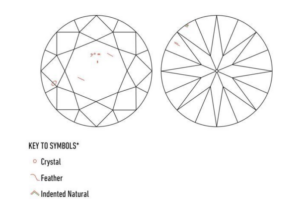
It identifies the crystal, feather, and indented natural but not the black spots.
But when you view the diamond in high-resolution on the vendor’s, those spots are obvious.
“Each black spot in a diamond is nature’s signature, making every stone a unique narrative of its miraculous journey from the earth’s mantle. These tiny marks are not just imperfections; they’re a testament to authenticity and history.” — Chuck Harris, Teach Jewelry
Can They be Removed?
The desire to remove black carbon specks in diamonds is understandable. There are methods that diminish the visibility, or in some cases remove them entirely.
But removal methods come at the cost of disrupting the structural integrity of the diamond.
Because black spots are an inclusion, meaning they appear on the inside of the diamond, it’s not possible to simply buff or polish them out. The surface of the diamond must be breached, and this inevitably introduces cracks or holes that weaken the gem.
The most common way to remove a black carbon flaw is by laser drilling. A laser is used to drill a microscopic hole to the black spot. Heat or acid is then funneled through this channel and burns away the black spot.
This leaves an empty space where the black spot used to be. These spaces (even if filled) are weak points in the diamond’s armor. If it’s hit too hard or at the wrong angle, the diamond can crack and splinter.
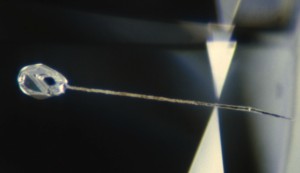
This is usually followed by a process called fracture filling, as the empty space and tunnel is filled with a clear, glass-like substance. This can affect the stone’s color and brilliance, as the foreign material has different properties than those of the diamond.
I tell readers it’s far easier to choose a diamond that never developed these noticeable black spots. Trying to remove them often isn’t worth the time, cost, or long-term affects on your diamond.
This is evident by the low prices you’ll find for treated diamonds. Even though they might initially appear clean, vendors know they aren’t worth nearly as much to buyers.
What do They Look Like?
Online jewelry retailers often let you view high-resolution photos of the diamonds before you buy them. This allows you to see examples of diamonds with black spots.
For example, this one carat diamond is graded an S12 clarity.
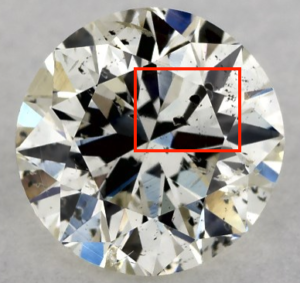
How to Make Black Spots on Diamonds Less Visible
1. Cover Them With Prongs or a Bezel Setting
This first method depends on the location of the inclusion, so it won’t work for all diamonds, especially ones with the black spots in the center.
If the flaw sits closer to the edge of the stone, it’s possible to cover it with the bezel or prongs of the setting.
To illustrate, check out the bezel setting below, and notice how it covers the outer edges of the diamond.
Diamonds can be rotated to fit under your chosen setting. This can be used to your advantage when buying a lower clarity stone.
If it has prongs that extend over its girdle, it could also over the black spots in a few places, but they’d have to be positioned perfectly.
You would never know a flaw existed unless you removed the diamond from its setting and scrutinized it.
Keep in mind this also works to the jeweler’s advantage when buying gems that are already pre-set, like engagement rings or other jewelry.
In these cases, you might decide to have the diamond removed so you can examine it in detail. You’ll ensure its setting isn’t covering up areas that significantly reduce its value.
2. Upgrade your Diamond
If you’re unable to hide black spots on your diamond with the methods above, the right choice may be to trade it in for a new one.
Some jewelers have upgrade policies. You can trade in your diamond and receive its full value toward a diamond that costs at least twice as much.
For example, at James Allen, my number one recommended jeweler, any loose natural diamond purchased from their store can be exchanged at 100% credit toward another natural diamond at least 2x or greater value. The same policy is available for lab-created diamonds as well.
But you don’t have to pay the premiums jewelers charge for flawless diamonds. In fact, prices generally rise 10 to 20 percent for every step up the clarity scale.
So if you originally bought an SI2 diamond, a flawless diamond could cost three or four times as much if the other qualities are equal.
I recommend finding a diamond with the lowest clarity grade that still appears eye-clean. You won’t learn whether it meets this criteria by viewing the GIA report, so you’ll have to view images or visit the jewelry store.
In my case, I landed on a VS1 round-cut diamond. I avoided the premium of higher grades, but if you didn’t know its clarity grade, you’d guess it was flawless.
Start your search at SI1, and work your way up the clarity scale until you find one where the black spots and other inclusions aren’t visible in a normal setting.
Should You Buy a Diamond With Black Spots?
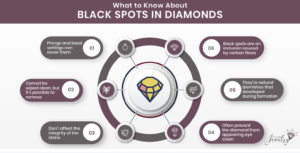
When you’re exploring which diamond is right for you, part of the process is examining it at every angle. If you’re considering a diamond toward the bottom of the clarity scale, black spots are likely present.
I recommend choosing a diamond without visible black spots. That’s what I chose when searching for an engagement ring. Even though I had to filter through dozens to find the right one, I’m glad it’s eye-clean.
Start your search at SI1, but if the diamond is larger than one carat, you’ll likely have to move up the scale. If you have budget constraints, consider VS1 or VS2 clarity to strike the balance between price and quality.
By viewing it in person or through high-resolution images to identify any black spots, you can discover which diamond has the right clarity for you.
Diamond Black Spots Q&A
Q1: Are black spots in diamonds more common in certain types of diamond cuts or shapes?
A1: Black spots, being natural inclusions, can be present in any diamond cut or shape. However, their visibility can be affected by the cut. Brilliant cuts like the round, princess, or cushion have facets arranged in such a way that they can sometimes hide these inclusions better than step cuts like emerald or asscher, where the wide, flat facets make inclusions more visible.
Q2: Is there any way to predict the likelihood of black spots in diamonds mined from specific geographic locations?
A2: The presence of black spots in diamonds isn’t typically tied to geographic location but rather to the individual conditions under which each diamond was formed deep within the Earth. However, some mines might have a higher incidence of certain types of inclusions based on the unique geological processes at play in those locations.
Q3: How does the size of a black spot affect the overall value of a diamond compared to other types of inclusions?
A3: The size of a black spot can significantly impact the value of a diamond. Larger and more visible black spots can lower the value more than smaller, less noticeable ones. Compared to other inclusions like feathers or pinpoints, a large black spot is more likely to detract from the diamond’s appearance and thus its value.
Q4: Can the presence of black spots influence the fire and brilliance of a diamond?
A4: Black spots themselves don’t typically affect the diamond’s fire (the dispersion of light into colors) or brilliance (the white light return). However, if the spots are large enough or numerous enough to interfere with light reflection and refraction within the diamond, they could potentially diminish its sparkle.
Q5: What are the long-term risks associated with laser drilling to remove black spots?
A5: Long-term risks of laser drilling include potential weakening of the diamond’s structure, making it more susceptible to damage if struck. The drilled pathways can also affect the diamond’s clarity and may require additional maintenance if the filling material degrades over time.
Q6: How does fluorescence in a diamond interact with black spots, if at all?
A6: Fluorescence, which is a diamond’s tendency to emit a soft glow under ultraviolet light, is generally unrelated to the presence of black spots. However, strong fluorescence can sometimes make inclusions like black spots less noticeable under certain lighting conditions.
Q7: Are there any advanced imaging technologies that can help buyers assess the impact of black spots in a diamond before purchase?
A7: Yes, there are advanced imaging technologies such as 360-degree videos, high-definition magnified photos, and even 3D modeling that allow buyers to inspect diamonds closely before purchase. These technologies can reveal the location, size, and impact of black spots, aiding in the decision-making process.
Q8: Are there any particular diamond settings that can enhance the perceived clarity of a diamond with black spots?
A8: Besides bezel and prong settings mentioned in the article, certain settings like halo or pavé can draw attention away from the center stone’s inclusions. A well-designed side stone setting can also play a role in enhancing the perceived clarity by providing visual distractions.
Q9: How do independent appraisals typically view diamonds with black spots compared to GIA grading reports?
A9: Independent appraisals take into account the same factors as GIA grading reports but may offer a more detailed analysis of how inclusions like black spots affect a diamond’s market value. Appraisers will consider the size, location, and visibility of the black spots, along with other quality factors, to determine the diamond’s value.

Jacob Clarke
Jacob Clarke is the founder of TeachJewelry.com.
He earned an Applied Jewelry Professional Diploma from the Gemological Institute of America (GIA) and now brings you essential information about diamonds, settings, and more.
Jacob has consulted with leading jewelry brands, and his work has been cited in Clean Origin, Diamond Nexus and industry publications.
He's also a member of the International Gem Society.
He enjoys discussing jewelry with readers, so contact him with any questions at jacob.clarke@teachjewelry.com.















